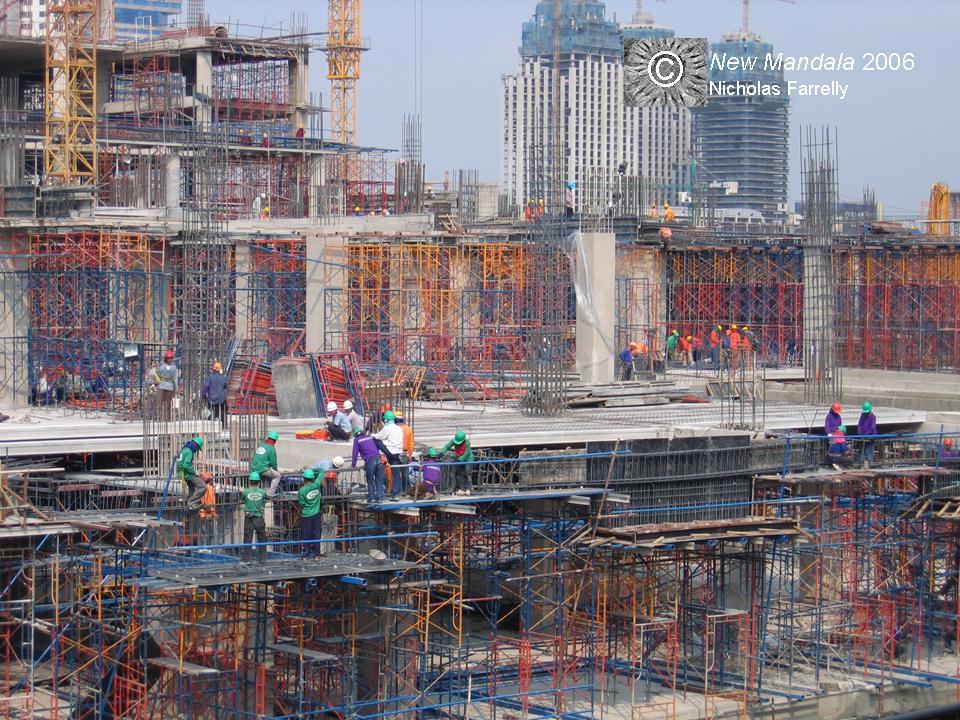Yesterday, Caretaker Prime Minister Thaksin Shinawatra was confronted by protestors as he visited Siam Paragon – an elite shopping centre in the heart of Bangkok. The centre, which occupies some of the most desirable real estate in the city, is an obvious place for a Prime Ministerial event. It is the newest addition to the long line of increasingly extravagant Thai shopping “experiences”. To give you an idea of Siam Paragon’s scale, I have included a photograph I snapped from the Siam Square Skytrain platform in 2004. It was then still under construction but was already enormous. It is now “uber-chic”.
Thaksin visited Siam Paragon to open an exhibition in honour of His Majesty the King. According to today’s papers, Thaksin, his supporters and his guards were confronted with an unexpected protest which – as seems to be the case more and more often in this year of confrontation – descended in to affray. One person quoted in the Bangkok Post article criticised yesterday’s protestors for wearing black clothes, “which was inappropriate for a function organised to honour the King’s Diamond Jubilee celebration”.
Thaksin, who was protected by a larger security contingent at a Ministerial event later in the day, threw in his own two satang, by saying, ”If they don’t want to vote for me, wait until Oct 15. This is not the right way to express opinions in a democratic country”. His attitude to the protestors is worth remembering. I expect this will be a sound bite we hear again and again over the next two months.
I wasn’t there to watch the protest yesterday but I was, I must confess, at Siam Paragon on Friday afternoon. It was my first visit to this monument to Thai initiative, capital and ambition. It no doubt cost an extravagant amount of baht to build and is now filled with a mind-boggling array of expensive designer loot.
What is most surprising is the incredible range of imported food available at the ground-floor supermarket. With hundreds of attendants to help discerning Bangkok shoppers make their selections, there are gourmet meats, cheeses, fish, fruit and vegetables (not to mention the aisles of packaged goods) for anybody with thousands of baht to spend on, say, a steak dinner. As far as I know, such a variety of very expensive food is unheard of anywhere else in Thailand, and probably in all of Southeast Asia. It is impressive, in its own way, and prompts much reflection…
I often wonder about the place of elite symbols, like Siam Paragon – which meekly bills itself as the “Pride of Bangkok” – in the world-view of groups like the current wave of anti-Thaksin protestors. Many protestors are obviously dissatisfied with the country’s situation. Some don’t just want a change of government; they want a change of national direction.
While I accept that toppling Thaksin is the immediate aim of the protests, it is worth asking whether the current round of arm-wrestling will lead to a more substantial backlash against “elites” and their interests. It may seem an unremarkable anecdotal observation, but it is true that very few of my Thai friends, colleagues or acquaintances could afford but the most perfunctory shopping trip to Siam Paragon. They know it was not built for them or their interests. I know they do not see it as the “Pride of their Bangkok”.
As different Thai visions collide and jostle for position, is the position of elites, as symbolised by Siam Paragon, going to remain secure? Is the employment that, say, Siam Paragon, or other elite interests, generate going to justify perpetual opulence and exclusivity? Will resentment against Thaksin – and what many see as nepotistic and immoral capitalism – lead to a broader backlash against Thai capital and its program? What political forces will be fertilised in the mud of the current impasse?
What will happen next?
In 2006, there are many questions and very few good answers. The year – one might rather ostentatiously conclude – is still a paragon of uncertainty.
 Facebook
Facebook  Twitter
Twitter  Soundcloud
Soundcloud  Youtube
Youtube  Rss
Rss 